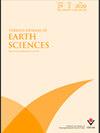Evidence for surface rupture of the 1939 Erzincan earthquake based on field data and paleoseismology on the Ezinepazarı Fault (North Anatolian Fault Zone, Central Anatolia)
IF 1.1
4区 地球科学
Q3 GEOSCIENCES, MULTIDISCIPLINARY
引用次数: 0
Abstract
: The Ezinepazarı Fault (EPF) is an active segment that restricts the Niksar Basin in the central part of the North Anatolian Fault Zone and has been the source of the devastating Mw 8.0 earthquake in the last 100 years. Traces of the surface rupture of the EPF, which occurred in AD 1939, can still be observed in the field today as a right-lateral strike-slip character. While paleoseismological studies were mostly focused on the western part of the North Anatolian Fault Zone (NAFZ) in previous studies, the studies on the central and eastern parts of the NAFZ are rarely addressed. In this context, trench-based paleoseismology studies were carried out on the surface rupture traces in order to determine both historical/prehistoric earthquakes caused by the fault and the Quaternary period characteristics of the EPF. According to the data obtained, at least two historical earthquake activities have been detected besides the last 1939 earthquake on the EPF. Accordingly, the first and second events occurred in E1: 5871 ± 2300 BP and E2: 1651 ± 128 BP, respectively. When the determined data are compared with the historical earthquake catalogs, it is concluded that Event 2 (E2) can be correlated with the AD 343 Niksar earthquake; thus, the EPF has an irregular earthquake recurrence interval.基于现场资料和北安纳托利亚断裂带ezinepazardi断裂带古地震学的1939年埃尔津詹地震地表破裂证据
ezinepazaryi断层(EPF)是一个活跃的板块,限制了北安那托利亚断裂带中部的Niksar盆地,在过去的100年里,它一直是毁灭性的8.0级地震的源头。发生在公元1939年的EPF地表破裂的痕迹,今天仍然可以在现场观察到右侧走滑特征。以往的古地震研究主要集中在北安那托利亚断裂带西段,而对北安那托利亚断裂带中东部的研究较少。在此背景下,对地表断裂痕迹进行了基于沟槽的古地震学研究,以确定断层引起的历史/史前地震和EPF的第四纪特征。根据获得的资料,除了1939年的最后一次地震外,在EPF上至少探测到两次历史地震活动。据此,第一和第二事件分别发生在E1: 5871±2300 BP和E2: 1651±128 BP。将实测资料与历史地震目录进行比较,认为事件2 (E2)与公元343年的尼克尔萨地震具有一定的相关性;因此,EPF具有不规则的地震复发间隔。
本文章由计算机程序翻译,如有差异,请以英文原文为准。
求助全文
约1分钟内获得全文
求助全文
来源期刊

Turkish Journal of Earth Sciences
地学-地球科学综合
CiteScore
2.40
自引率
10.00%
发文量
6
审稿时长
6 months
期刊介绍:
The Turkish Journal of Earth Sciences is published electronically 6 times a year by the Scientific and Technological Research
Council of Turkey (TÜBİTAK). It is an international English-language journal for the publication of significant original recent
research in a wide spectrum of topics in the earth sciences, such as geology, structural geology, tectonics, sedimentology,
geochemistry, geochronology, paleontology, igneous and metamorphic petrology, mineralogy, biostratigraphy, geophysics,
geomorphology, paleoecology and oceanography, and mineral deposits. Contribution is open to researchers of all nationalities.
 求助内容:
求助内容: 应助结果提醒方式:
应助结果提醒方式:


